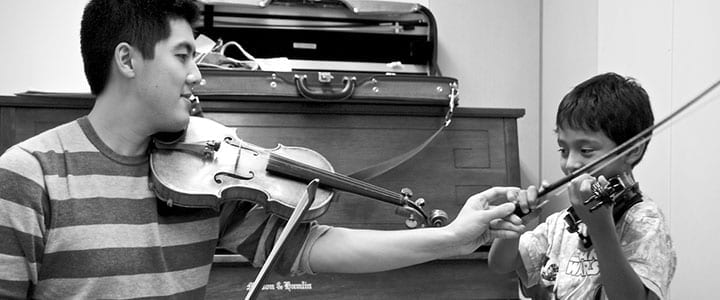Are you thinking about having your child start violin lessons? There are several different musical teaching methods you can consider. Below, violin teacher Julie P. shares some of the benefits of the Suzuki violin method…
Since it’s inception over 50 years ago, thousands of people have learned to play the violin using the Suzuki method, many of whom have gone on to become renowned professional musicians.
Created by Japanese violinist Shin’ichi Suzuki, the method is based on the notion that all children can learn to play a musical instrument the same way they learn to speak their native language.
History of the Suzuki Violin Method
Shin’ichi Suzuki was born on October 17, 1898, in Nagoya, Japan. While Suzuki’s father owned a violin factory, it wasn’t until he was 17 years old that Suzuki became interested in playing the violin.
After taking lessons from a teacher in Tokyo, Suzuki traveled to Germany to study with famous violin teacher Karl Klingler. Shortly after meeting his wife, Suzuki moved back to Japan where he started to teach violin and later create the Suzuki violin method.
Also known as the Mother Tongue Method, the Suzuki approach was created on the notion that the same principals children use to learn their “mother tongue” can be also be applied to learning the violin.
The teaching philosophy has enabled thousands of children to play various instruments and has become one of the most popular methods today’s music teachers use. To learn more about the history of Shin’ichi Suzuki, click here.
7 Principals of the Suzuki Violin Method
The Suzuki method is a great way to for children to learn the violin. Students of all ages stand to benefit from its structure, group learning environment, and focus on discipline.
If you’re wondering whether the Suzuki violin method is right for your child, check out the seven main principals of the teaching method below.
1. Structure
The Suzuki method is a very structured approach to learning. Programs are typically made up of a combination of private lessons, group lessons, and theory classes. Children are expected to attend all classes, as well as practice every day at home.
It is believed that repetitive practice of songs and exercises over weeks and months leads to a mastery of the skills being taught.
2. Listening
In the Suzuki philosophy, it’s believed that listening to music every day is important for the musical development of the student. Children are encouraged to listen to music daily, especially recordings of the songs they are learning in their lessons.
If your child loves to listen to music, the Suzuki method is a great fit. They will find great enjoyment in listening to the Suzuki repertoire as well as learning how to play along.
3. Group Lessons
The group lessons are beneficial for many children. Groups are determined by ability as opposed to age. While this might be intimidating for some young children, it might motivate others who look up to older children within their group.
Playing and practicing with other children is fun for students, and many of them will go on to build lasting friendships through their Suzuki program. Students also find motivation from group lessons, as they are challenged to keep up with the class.
4. Performances
Recitals play an important role in the Suzuki learning process, as they give all students a chance to showcase what they’ve learned and practice in front of a crowd. Group performances create a safe environment for children who might be nervous about performing in front of others.
Younger students are often inspired when they hear the performances of more advanced students, and look forward to someday performing those pieces themselves.
5. Rote Learning
Beginner Suzuki students learn all songs and exercises by memory. This allows them to focus on the skills necessary for playing the violin, without having to worry about trying to read music.
Students learn to read music after their skills have advanced to a point where their playing is more fluid. This approach is great for young children, as well as those who struggle with reading or other visual tasks.
6. Commitment
Students in a Suzuki program usually have to two to three classes/lessons per week, which is a significant commitment. Additionally, the daily practice expectation is taken very seriously.
If your child is already in a number of activities that demand much of his or her time, Suzuki may not be a good fit. However, students in the Suzuki program benefit greatly from the high frequency of classes, as skills are repeatedly reinforced.
SEE ALSO: How to Motivate Suzuki Students to Practice
7. Parental Involvement
One last thing to consider when deciding if the Suzuki violin method is right for your child is the required commitment from parents. Parents are expected to learn the violin alongside their child, attending all lessons and classes, and directing practice sessions at home.
Sometimes there are even group lessons just for parents, as well as separate private lessons if parents need more help with learning the violin.
The Suzuki method has been an effective way to learn the violin for decades. While the commitment is significant, Suzuki programs can be a great bonding experience for parents and children.
Finally, practicing the Suzuki violin method can also be a great family social activity, as Suzuki programs tend to create strong communities among the participating families.
 Julie P. teaches flute, clarinet, music theory, and saxophone lessons in Brooklyn, NY. She received her Bachelor’s degree in Music Education from Ithaca College and her Masters in Music Performance from New Jersey City University. Learn more about Julie here!
Julie P. teaches flute, clarinet, music theory, and saxophone lessons in Brooklyn, NY. She received her Bachelor’s degree in Music Education from Ithaca College and her Masters in Music Performance from New Jersey City University. Learn more about Julie here!
 Photo by Nathan Russell
Photo by Nathan Russell
Suzy S.

